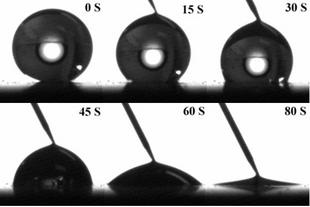| Nanotechnology | |||
Electrically controlled nanotube membranes produce powerful water filtration device2 March 2007 Low voltages can precisely and selectively control the flow of water through nanotube membranes, according to recent research at Rensselaer Polytechnic Institute, USA. Potential applications include chemical micro-filtration and separation, the production of safe drinking water, biomedical research, and advanced circuitry. The research, which will be described in the March 14, 2007 issue of the journal Nano Letters, could inspire technologies designed to transform salt water into pure drinking water almost instantly, or to immediately separate a specific strand of DNA from the biological jumble.
Nanotube membranes have fascinated researchers with their combination of high flow rates and high selectivity, allowing them to filter out very small impurities and other organic materials like DNA and proteins from materials with high water content. The problem is that nanotube arrays are hydrophobic, strongly repelling water. “We have, at a very fundamental level, discovered that there is a new mechanism to control water transport,” said Nikhil Koratkar, associate professor of mechanical engineering at Rensselaer and lead author of the paper. “This is the first time that electrochemical means can be used to control the way that the water interacts with the surface of the nanotube.” A group of Rensselaer researchers led by Koratkar has found a way to use low-voltage electricity to manipulate the flow of water through nanotubes. Control of water’s movement through a nanotube with this level of precision has never been demonstrated before. “In this century one of the big challenges is how to get clean drinking water,” Koratkar said. “If you can remove salt from water you can solve this problem. Nature does this all the time. The first step to getting to this process is to control the flow of water through nanochannels, which we have now successfully demonstrated. This is the starting part of the research. The next step would be to capture specific proteins, DNA, or impurities within the water with specifically designed nanotubes.” The researchers discovered that when the nanotube’s membrane is given a small positive potential of only 1.7 volts, and the water is given a negative potential, the nanotubes quickly switch from repelling water to pumping water through the tube. When the charge on the water is raised, the water flows through at an exponentially faster rate. When the experiment is reversed with a negatively charged nanotube, it takes much higher voltage (90 volts) to move the water through the tube. By simply reversing the polarity of the nanotubes, the team found that they could actually start and stop the flow of water through the tube. When a small positive charge is administered the water moves through the tube, and when that charge is reversed the water flow stops. The researchers determined that the nanotube walls had been electrochemically oxidized as a result of water electrolysis, meaning that oxygen atoms had coated the surface of the nanotubes enabling the movement of water through the tube. Once the charge is reversed, oxidation stops and the water can no longer flow through the unoxidized portion of the tube. The researchers also discovered that they could control the rate of water flow through nanotubes sitting directly next to each other, allowing one tube to pump quickly while the one next to it didn’t pump water at all. Such an extreme difference in water absorption so close together is unprecedented, and could have major implications for time-released drug coatings, lab-on-a-chip devices, and water capture that mimics some of nature’s most efficient water-harvesting materials. The research is the first step to creating nanotube devices built to filter out specific elements from water and organic materials. With this enabling research in place, more efficient micro-filtration and separation techniques can be created for environmental restoration, the production of safe drinking water, biomedical research, and advanced circuitry. Pulickel Ajayan, the Henry Burlage Professor of Materials Science and Engineering at Rensselaer and a world-renowned expert in fabricating nanotube materials, collaborated with Koratkar on this project. Four other Rensselaer researchers were involved with the research: Saroj Nayak, associate professor of physics; post-doctoral researcher Lijie Ci; and doctoral students Li Chen and Zuankai Wang.
|
